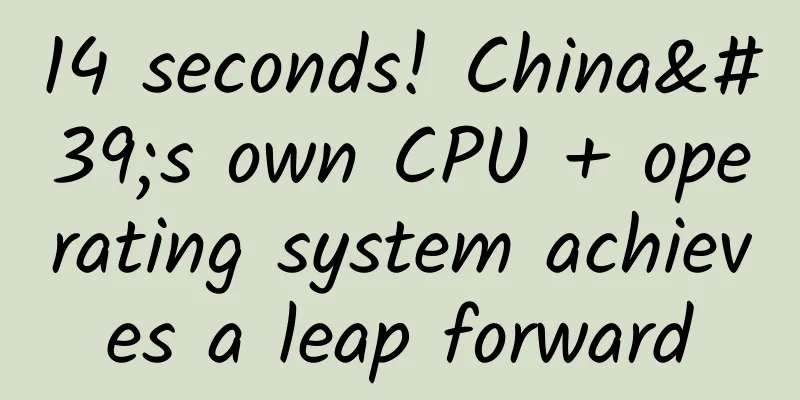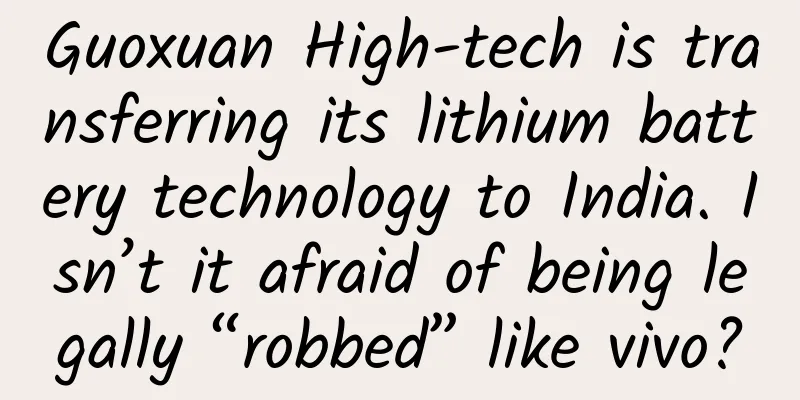14 seconds! China's own CPU + operating system achieves a leap forward

|
1 second, 2 seconds, 3 seconds... Several "coders" from Beijing's information technology companies sat around a laptop, holding their breath and concentrating, their hearts seeming to beat in sync with the second hand. At the 14th second, the computer desktop "lit up" successfully, and the laboratory was suddenly filled with joy. From fighting alone to joining forces, Tongxin has joined forces with upstream and downstream companies in the industry to jointly promote the development of domestic operating systems. With the rapid iteration of technology, the boot time of domestic operating systems has been shortened step by step, and finally achieved a leap to 14 seconds in 2022 . In March 2022, a Tongfang laptop computer equipped with a Loongson 3A5000 quad-core processor, Tongxin UOS operating system, and Kunlun BIOS firmware achieved a leap-forward breakthrough in boot time of 14 seconds. Computers representing "Chinese core" and "Chinese soul" are moving from "usable" to "easy to use", expanding the place of Chinese people in the information technology industry that has been occupied by Intel and Microsoft for many years. Every line of code that leaps towards "14 seconds" hides the creativity and ambition of several generations of "Beijing coders". They represent Beijing's "soft power", some of whom have been working for decades, and some are young people who have just entered the industry. The difficulties in the chain of information technology application innovation are making key breakthroughs through their joint efforts. Loongson CPU emerges from its "darkest moment" Boot speed is the first impression that a computer's performance leaves on users. Ten years ago, it took 10 minutes or even longer to boot up a computer equipped with domestic hardware and software. The CPU (central processing unit) is the heart of the computer. If you want to speed up your computer, you must first pass this level. Do Chinese people have their own CPU? Yes. In the early morning of August 10, 2002, a computer equipped with the "Loongson 1" CPU was successfully started, ending the history of Chinese people relying entirely on imported CPUs to manufacture computers. In 2010, the Chinese Academy of Sciences and the Beijing Municipal Government jointly invested in the establishment of Loongson Zhongke Company, hoping to accelerate the industrialization of research and development results. However, just over two years later, Loongson Technology fell into its "darkest hour". The academic-oriented Loongson team has been focusing on improving CPU performance, but has been slow to come up with a general-purpose CPU that meets the mainstream market demand. The high investment in research and development has put the company on a tight budget, and it was even unable to pay salaries, leading to a loss of talent. "This crisis forced us to face reality." Founder Hu Weiwu realized that the Loongson R&D personnel who "went into business" gave up the establishment of the Chinese Academy of Sciences, but forgot to pay attention to the real needs of the market. In other words, although the organization has transformed, the concept has not kept up. ▲Hu Weiwu, chief engineer of the Institute of Computing Technology of the Chinese Academy of Sciences and chief designer of Loongson At that time, the mainstream CPU in the market was a multi-core design. Intel focused on dual-core and quad-core. In order to be superior, Loongson started with eight cores. Hu Weiwu frankly said that the premise of "strength in numbers" is that everyone must be strong. Although Loongson has eight cores, the performance of each core is inferior to others. Loongson's CPU was not accepted by the market at that time for a simple reason - it was not easy to use. After several years of detours, Loongson finally put aside its pride and set its sights on CPUs in the industrial control field, and later successfully applied them in the information field. Through continuous trial and error and iteration, Loongson's revenue exceeded 100 million yuan in 2015, achieving break-even for the first time. From 2015 to 2020, the performance of Loongson increased 10 times, which made it possible to support a 14-second boot time. The CPU of Tongfang computers, which has been shortened to 14 seconds, is the Loongson 3A5000 series, whose performance is close to the mainstream level of open market CPUs. Domestic operating systems are beginning to mature For most computer users, the classic icons of the Windows operating system are deeply engraved in their memories. The CPU is the heart of the computer, and the operating system is the soul. If Loongson is benchmarked against Intel, then who can be benchmarked against Microsoft? In 2011, when Hu Weiwu was striving for a higher level of CPU, Liu Wenhuan, general manager of Tongxin Software Company, decided to start a business from scratch and build a domestic operating system. "If conquering chip technology is like climbing the Himalayas, then solving the domestic operating system is like exploring the Mariana Trench." Prior to this, he had worked in an information security company for more than ten years, and increasingly felt that if the operating system bottleneck could not be resolved, information security would only be talk on paper. During the same period, a number of software companies with the same ideals were born in China. However, ideals are full of hope, while reality is skinny. The first wave of people who tried it found that computers equipped with domestic operating systems were not only slow, but also unable to chat, work, and play games like Windows. Although new domestic systems were constantly launched, these software companies fell one after another in the face of technological gaps and the cruel choices of the market. Overcoming difficulties cannot be solved by one person alone. To solve the user pain points such as slow boot and short battery life, the CPU, operating system and other industries must work together to tackle the problem. In 2019, Tongxin Software Technology Co., Ltd., jointly established by multiple domestic operating system manufacturers, was established with its headquarters located in the Beijing Economic and Technological Development Zone Xinchuang Park. It has also established technical support agencies, R&D centers and general software and hardware adaptation centers in Wuhan, Shanghai, Guangzhou and other places. From fighting alone to joining forces, Tongxin has joined forces with upstream and downstream companies in the industry to jointly promote the development of domestic operating systems. With the rapid iteration of technology, the boot time of domestic operating systems has been shortened step by step, and finally achieved a leap of 14 seconds in 2022. "The gap between domestic operating systems and products from top international manufacturers has shrunk from 10 years or even longer to 3 to 5 years," said Liu Wenhuan. Today, Tongxin operating system has been implemented in many key industries such as banks and telecom operators, and the latest home version was also launched at the beginning of this year. However, the new domestic operating system still faces the risk of "supply cut" from the upstream open source community, which in turn affects the sustainable development of the industry. "The reason is that the root community of the domestic Linux open source system is located abroad." Liu Wenhuan said that the root community can help operating system manufacturers get rid of the constraints of the upstream open source community and obtain better protection at the information security level. Figuratively speaking, the "supply chain" must also be safe. Two months after achieving the 14-second boot-up time, Tongxin launched China's first desktop operating system root community, the "Deepin Community", based on the world's three major independent open source communities. Starting from the "root", it has mastered the development rights of the open source operating system and the dominance of the upstream community, attracting global enthusiasts to contribute code and ideas to the domestic operating system. "Raising" an independent industrial chain In 2014, the popular Windows XP system was discontinued, and a large number of enterprises and individual users were confused. Although most functions can still be used normally after the discontinuation of service, they cannot obtain Microsoft vulnerability patches and system upgrade support, making them vulnerable to viruses and hacker attacks. Six years later, the same situation happened when Windows 10 was discontinued. This further stimulated Beijing's motivation to build an independent information and innovation industry system. Thirty years ago, Hu Weiwu, who was a doctoral student at the Chinese Academy of Sciences, needed to use a high-performance computer that had just been introduced from abroad for his experiment. However, the password of this computer was in the hands of foreigners, and he had to be monitored and operated in a glass house when using it. This image was deeply engraved in his mind. Therefore, when Loongson was just starting out, all the well-known companies that could be thought of came to Hu Weiwu to discuss technology licensing cooperation. "I interpreted these actions as 'surrendering your weapons but not killing you'!" He saw that behind the technology licensing was to make Loongson give up its ability to innovate and develop, so he decisively refused. 30 years later, the young man in red has become a white-haired man, and Hu Weiwu has started another more thorough and difficult "entrepreneurship". The global information industry is mainly built on two ecosystems based on instruction sets and chip designs: Wintel (Microsoft-Intel Alliance) and AA (Android-ARM). If you want to produce a CPU that matches them, you must first obtain the instruction set "authorization." "If you want to make a completely independent and innovative CPU, you must also achieve independence at the underlying technical level of the instruction set." In 2021, Loongson Technology officially released the Loongson independent instruction system architecture LoongArch, achieving a major technological breakthrough in its ecosystem construction. This marks that Loongson Technology has moved from follow-up development to completely independent development in the construction of independent information technology systems and industrial ecosystems. The Loongson 3A5000, which supports a 14-second boot time, uses the LoongArch independent instruction system architecture and no longer requires foreign authorization. One innovative breakthrough after another has tempered Beijing's information and communication technology industry chain: a number of global benchmark products such as ZTE Database, Guoke Tianxun Avionics Bus Protocol Chip, and Qingteng Cloud Security have been born, and the domestic information technology system has been initially formed. The National Information and Communication Technology Park on the shores of Tongming Lake in Beijing Economic and Technological Development Zone has gathered more than 90% of the country's leading information technology companies, forming an information and communication technology industry chain covering the entire industry chain including high-performance chips, operating systems, databases, complete machine terminals, system integration, and network security services. ▲"Ecological Adaptation and Dispatching Center" of Tongxin Software Technology Co., Ltd. in Beijing Economic and Technological Development Zone National Infotech Park "Some products are like raising pigs, which can be slaughtered and eaten in one year; some products are like raising cattle, which can plow the fields and work in three years; our products are like raising children, which take twenty years to mature into useful materials." Hu Weiwu compared technological breakthroughs to "raising children", which vividly condensed the difficult process of breakthroughs in information technology and also indicated that the independence of the information and innovation industry still has a long way to go. The "Beijing coders" who have worked hard for many years still need to make greater innovative breakthroughs to match the international best and lay a solid "foundation" for China's economic digital transformation and industrial chain upgrading. |
>>: The first self-developed machine in China! It has achieved a major breakthrough from scratch →
Recommend
Uncle Operations: I wish all CPs and channel partners in the mobile circle a happy Mid-Autumn Festival!
During this typhoon, I body exist Xiamen, a beaut...
Four marketing techniques for jewelry industry on Xiaohongshu
Some time ago, a friend of mine on Xiaohongshu to...
Sichuan scenic spots have resumed opening! What should we pay attention to? Attached is a complete list of precautions!
Due to the impact of the epidemic, many restauran...
From 0-1 to build operational live broadcast training: anchor foundation, mentality shaping, ability training to live broadcast rhythm, speech skills
From 0-1, we will build operational live streamin...
Tips for creating hit events!
We often hear about cases of hit activities and p...
The core model and skills of community operation!
This year, the term " community operation &q...
Advanced live broadcast room operation, save it now!
1. Live broadcast content planning Some students ...
Are mobile QQ red envelopes really generous? QQ Spring Festival red envelope strategy
[[381468]] The New Year red envelope activities o...
5 Examples of User Growth for SaaS Products
This compiled article mainly introduces the low-c...
Poisoning caused by boiling tea around the stove, what's going on? Eating hot pot also has this hidden danger!
On a cold winter day, people gather around a smal...
Sanmenxia SEO training: What are the effects of external links on SEO websites? How to make friendly links?
In the SEO optimization industry, there is a sayi...
You must be kidding! How can there be sharks in the lake? !
Shark watching in the lake? It's not a fantas...
Annual review | 3 key words for brand marketing in 2019
Introduction: Frequent collaborations, frequent h...
E-commerce Operations丨How to write store text messages to attract customers?
The quality of a text message promotion copy ofte...









